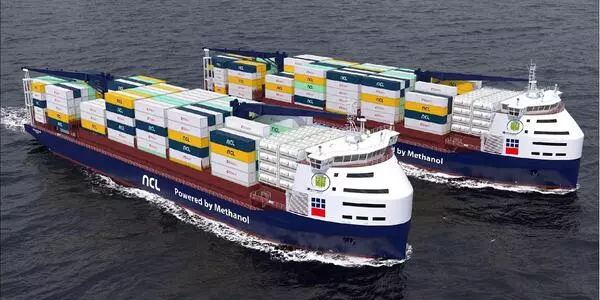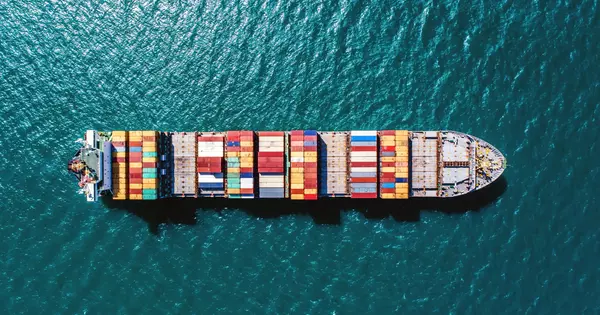A new study published in Science Advances by UMBC’s Tianle Yuan used satellite data from 2003 to 2020 to determine the effect of fuel regulations on cargo ship pollution. The data collected by the research team revealed significant changes in sulfur pollution following the implementation of regulations in 2015 and 2020. Their extensive data set can also help to answer a larger question: What effects do pollutants and other particles have on global temperatures when they interact with clouds?
Aerosols, which are tiny particles in the atmosphere that include pollution, can harm human health, but they also have a cooling effect on the planet due to how they interact with clouds.
“How much cooling the aerosols cause is a big unknown right now, and that’s where ship tracks come in,” says Yuan, an associate research scientist at the Goddard Earth Sciences Technology and Research (GESTAR) II Center.
Ship pollution alone can create a substantial cooling effect, because the atmosphere over the ocean is so clean. There is a physical limit to how small cloud droplets can get, so at a certain point, adding more pollution doesn’t increase the clouds’ cooling effect.
Tianle Yuan
Sea of data
When pollutant particles from ships enter low-level clouds, they reduce the size of individual cloud droplets without changing the total volume of the cloud. This increases the surface area of droplets, which reflects more energy entering Earth’s atmosphere back into space and cools the planet.
These differences in droplet size can be detected by satellite instruments. And, because the air above the ocean is generally very clean, the relatively narrow ship tracks that snake across the ocean are easy to spot. “The majority of the original cloud is unpolluted, and then some of it is polluted by the ship, creating a contrast,” Yuan explains.
While ship tracks in satellite data can be fairly obvious, you must know where to look and have the time and resources to search. Yuan claims that before advances in computing power and machine learning, Ph.D. students could devote their entire thesis to identifying a group of ship tracks in satellite data.
“We automated this process,” Yuan explains. His team “created an algorithm to automatically detect these ship tracks in a sea of data.” For the first time, they were able to create a comprehensive global map of ship tracks over a long period of time (18 years). They will then share it with the rest of the world, allowing anyone to dig into the data and make new discoveries.

Disappearing act
Even before pollution-limiting regulations were put into place, Yuan and his colleagues found that ship tracks didn’t occur everywhere ships were traveling. Only areas with certain types of low cloud cover had ship tracks, which is useful for adjusting the role of clouds in climate models. They also found that after Europe, the U.S., and Canada instated Emission Control Areas (ECAs) along their coastlines in 2015, ship tracks nearly disappeared in those regions, demonstrating the efficacy of such regulations for reducing pollution in port cities.
However, shipping companies did not necessarily reduce their pollution output across the board. Instead, they made changes to conform to the new rules. Ports in northern Mexico (which are not part of the ECA system) saw increased activity, and pollution “hot spots” formed along the boundaries of the ECAs as ships altered their routes to spend as few miles as possible inside the restrictive zones.
However, in 2020, an international agreement established a much stricter standard for shipping fuel across the entire global oceans, rather than just near coastlines. Following that, the only ship tracks detected by the team’s algorithm were those in the cleanest clouds. The presumed ship tracks blended right in with the clouds, even with minor background pollution.
Climate conundrum
It appears obvious that reducing ship pollution would result in a net benefit. However, because particles (such as shipping pollution) have a cooling effect when they interact with clouds, significantly reducing them could contribute to a problematic rise in global temperatures, according to Yuan.
That is another reason why it is critical to confirm the extent to which particulate pollution cools the planet. If the cooling effect of these pollutants and other particles is significant, humans will need to balance the need to avoid widespread warming with the need to reduce pollution in areas where people and other species live, which will necessitate difficult decisions.
“Ship pollution alone can create a substantial cooling effect,” Yuan says, “because the atmosphere over the ocean is so clean.” There is a physical limit to how small cloud droplets can get, so at a certain point, adding more pollution doesn’t increase the clouds’ cooling effect. But over the ocean, because the background is largely unpolluted, even a small amount of pollution from ships has an effect.
Ocean pollution is also an outsize driver of the cooling effect of aerosols, because low clouds, which are most conducive to creating ship tracks, are more common over water than on land. And, as Yuan reminds us, “the ocean covers two-thirds of the Earth’s surface.”
The bigger picture
Moving forward, Yuan and his colleagues are assisting in resolving this conundrum by continuing to define the role of clouds in climate more precisely. “We can use the millions of ship track samples we now have to start getting a handle on the overall aerosol-cloud interaction problem,” Yuan says, “because ship tracks can be used as mini-labs.”
By analyzing data from a relatively simple and well-controlled system — narrow ship tracks running through very clean clouds — they can come to conclusions they can be confident about.”
Other research teams can use the team’s data set and algorithm to reach their own conclusions, increasing the potential public impact of this work. This collaborative spirit will assist scientists and communities in determining how to best address global challenges such as pollution and climate change.





